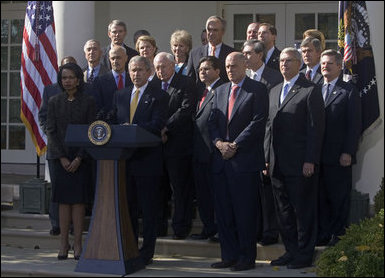|
|
|
|
 |
Home >
Government
 |
 |
 |
 President George W. Bush stands with his Cabinet during a Rose Garden address to the media. "As the new members of Congress and their leaders return to Washington, I've instructed my Cabinet to provide whatever briefings and information they need to be able to do their jobs," said the President. "The American people expect us to rise above partisan differences, and my administration will do its part." White House photo by David Bohrer
President George W. Bush stands with his Cabinet during a Rose Garden address to the media. "As the new members of Congress and their leaders return to Washington, I've instructed my Cabinet to provide whatever briefings and information they need to be able to do their jobs," said the President. "The American people expect us to rise above partisan differences, and my administration will do its part." White House photo by David Bohrer |
|
|
 |
| Executive
Office of the President
|
 |
 |
| Branches
of Government |
 |
 |
 |
 Executive Branch
Executive Branch
The power of the executive branch is vested in the President, who also serves as Commander in Chief of the Armed Forces.
|
|
 Judicial Branch
Judicial Branch
The judicial branch hears cases that challenge or require interpretation of the legislation passed by Congress and signed by the President. |
|
 Legislative Branch
Legislative Branch
The legislative branch of the federal government consists of the Congress, which is divided into two chambers -- the Senate and the House of Representatives.
|
 |
| Additional
Government Resources |
 |
 |
 |
Agencies & Commissions
An alphabetized list of different Federal Agencies and Commissions.
|
|
Federal Statistics
The purpose of this service is to provide easy access to current Federal
economic indicators. |
|
Citizens Handbook
Located in this handbook are a number of useful ways of finding government
information.
|
 |
Fellowships / Internships
White House Fellowships and Internships offer exceptional young men
and women first-hand experience working and observing at the highest
levels of the federal government.
Fellowships »
Internships »
|
|
Appointments
One of President Bush's top priorities is to select men and women
of the greatest ability and highest ethical and professional integrity
to serve in policymaking and key administrative positions.
Nominations » Application
» |
|
Freedom of Information Act
The President's immediate personal staff and units within the EOP
whose sole function is to advise and assist the President are not
subject to FOIA. |
 |
|
|
|
|
|